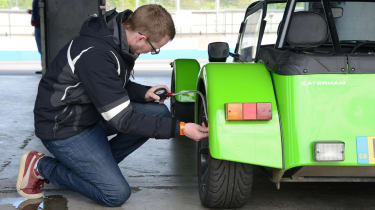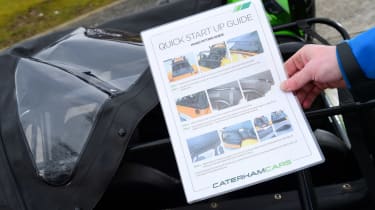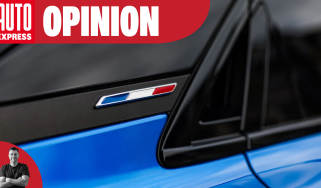Long-term test review: Caterham Seven 310S
Final report: After 12,000 miles and 10 months of thrills, our man doesn’t want to let the Caterham Seven 310S leave our fleet

By upgrading the 270 to 310 spec, Caterham has delivered one of the best balanced Sevens ever, mixing speed and poise in a fun package. It’s still a lot of money for a car most people will only use at weekends, but the upgrade is worth it to find a new sweet spot in Caterham’s range.
Mileage: 12,600Economy: 34.5mpg
After 10 months on our fleet, the sad day has come to say goodbye to our Caterham Seven. And it is sad, because I’ve really bonded with the car. So when Caterham came to try to take it away, my natural reaction was to put up a protest.
I lay down in front of it, Tiananmen Square style, and even blocked it in with railings, but couldn’t stop the inevitable. After exactly 12,600 miles it returned to Caterham in time for its second service.
Our S pack model was introduced as part of the range revamp last year, and we set out to see if this was the most usable Seven yet. Having covered more than the UK average annual mileage in just 10 months, I can safely say my research was thorough.
Before I tell you what I think of the car, there’s a caveat – the Seven was never going to rival even a supermini for practicality. But it’s surprising just how easy it is to live with if you’re prepared to make a few sacrifices for running one of the world’s best sports cars.
Used - available now

2020 Vauxhall
Corsa Electric
8,241 milesAutomaticElectric
Cash £11,365
2023 Hyundai
Tucson
27,571 milesAutomaticPetrol1.6L
Cash £20,300
2021 Ford
Mustang Mach-E
28,288 milesAutomaticElectric
Cash £21,300
2023 MG
MG4 EV
54,069 milesAutomaticElectric
Cash £10,200The boot proved big enough for my weekly shop, plus due to the amazingly low kerbweight, fuel economy has been impressive, too, while commuting into central London has been a real giggle as you skulk around at wagon-wheel height.
While the car is noisy on the move, the ride on the motorway is okay, and the extra few inches of space from the wider SV body add that bit more usability. It’s no more difficult to live with than a Mazda MX-5 – except it’s a lot faster and sharper to drive.
I specified sport suspension dampers from the factory, which made it a little less settled on country roads, but they give an incredible connection to the car. The steering is beautifully weighted and, as there’s no power assistance, totally uncorrupted. It means you can get on with the job of driving for pure pleasure, and since the upgrade to 310 specification, the extra power unlocked a new-found balance in the chassis.
The engine and gearbox combination (a five-speed unit with longer ratios for easier cruising) is brilliant, with a delicious mechanical precision to the shift that meant I found myself changing gears just for fun.
However, it hasn’t all been plain sailing, as I’ve had a few niggles with the car: the headlight blew, it’s broken two indicator flasher units, the foglight lens cracked, the soft alloy wheel developed a flat spot after going through a pothole and a few bits of trim are starting to look a little tired.
Still, as the Caterham has lived outside for half of its life, I’m impressed by how it’s stood up to punishing wintery conditions and more miles in 10 months than some Seven owners will do in 10 years. It’s an easy car to love; the two-seater’s personality gets under your skin and infects you with its charm.
Caterham 310S: fifth report
Mileage: 10,682Economy: 32.3mpg
There’s a famous phrase that goes: “Power tends to corrupt, and absolute power corrupts absolutely.” But in the case of our Caterham Seven, a little bit of extra power has done exactly the opposite.
Our car started life as a 270S with 135bhp, but following the recent release of the Seven 310 model, the kind folks at Caterham have upgraded our car to 310 specification, so our Seven now produces a more potent 152bhp.
The upgrade costs £1,495 (or £24,995 fully built as a standalone model), and this is what Caterham ownership is all about – many owners continually tweak their cars to improve the performance. And while an extra 17bhp doesn’t sound like a massive increase, the car only weighs 550kg, so a greater than 10 per cent boost in power has had a pronounced effect.
If you’re mechanically minded and fancy wielding the spanners, you can roll your sleeves up and perform the work yourself, although we’d only recommend doing so if you’re confident with car mechanics. The extra horses come from a new set of high-performance camshafts for the 1.6-litre unit to improve the engine’s breathing, and revised engine mapping to make the most of those mechanical changes.
The upgrade stemmed from Caterham’s motorsport programme, giving existing racers a logical stepping-stone up the ladder from 270 spec. Our last report from a track session at Donington Park in Leicestershire highlighted that the Seven could do with just a bit more power to make it more exciting, and that’s exactly what Caterham has given it.
Rather than corrupting it, the increased output has unlocked a new-found balance in the Seven. In 270 trim, the car had a surfeit of grip over power and wasn’t as adjustable using the throttle, but with the 310 upgrade, you can use the accelerator to change the car’s cornering line with almost as much accuracy as the steering.
You don’t have to put the Caterham into a lurid drift to do this, either – although it’ll happily oblige if you’re in safe surroundings and want to. Instead, the extra urgency everywhere in the rev range means the car is more willing to respond to a stab of gas or a little lift of the throttle, tightening its line with plenty of security.
The extra adjustability the upgrade has injected into the Seven seems to heighten the feedback the chassis gives, too. It wasn’t exactly lacking in this area, but the car feels more alive, and fizzes with energy when you drive it quickly.
Along with the extra power, there’s more torque in the mid-range, so the Seven snaps out of corners, zipping through the five-speed box with greater drive.
It’s incredibly playful, and the upgrades have changed the character of the motor by a surprising degree. There’s more power everywhere, but the rev needle now really rips round to its 7,500rpm red line. The noise from the side-exit exhaust hardens from a bassy blare into a demented howl in the process, with plenty of pops and cracks when you lift off the accelerator.
But it’s not just through the seat of your pants that you can tell the 310 is more alive compared with the 270; the 0-60mph time has dropped from 5.0 seconds to 4.8, while top speed is up 4mph to 126mph, too.
Caterham 270S: fourth report
Mileage: 7,841Economy: 36.1mpg
Not all relationships run smoothly, and although I’ve been getting on with our Caterham Seven 270S fine up to now, on my way to Donington Park recently it ground to a halt. While the fuel gauge was showing an eighth of a tank left, the car had run out of petrol, leaving me stranded on the M1.
Let’s rewind a moment, though. We’ve lived with the Caterham through winter, and while it’s performed (almost) faultlessly, now summer is here we’re savouring plenty of roof-down road drives. But many Seven owners also enjoy their cars on track, so what better way to get a taste of its true performance than on a race circuit?
Undeterred, once the recovery service had topped me up with petrol (I’ve since sorted the faulty fuel sender), I carried on my way to a Donington track day run by Caterham’s partner, BookaTrack, to explore what makes driving a Seven so special. At £295 it’s a top-value way to learn your car’s limits in safety.
Our model is geared more towards road use with its softer suspension, but the basic Caterham traits are still present and correct. So rolling out of the pitlane and into turn one, the level of confidence it inspired thanks to the detailed feedback meant you couldn’t help but pick up the pace.
The first session on track revealed how sweet the Caterham’s chassis is, with beautiful balance and adjustability through the fast turns. After a quick break for both me and the car, with a few tweaks to tyre pressures helping to improve grip, I headed back out, interested to learn more.
The main lesson is you don’t need lots of power to have fun – or go fast. Thanks to the Caterham’s low kerbweight you can stay on the power and brake as late as you dare; in hot hatches and performance coupés you have to lift and slow much earlier. Yet while you can take liberties on the way into bends, the Caterham falls down coming out of them.
On full throttle up Donington’s steep hill and then down the back straight, the 135bhp 1.6-litre engine feels a little breathless as the track surroundings sap the sense of speed. But the moment you approach the tight Fogarty Esses chicane, the 270S simply devours the road, skipping through the fast left-right direction change on the edge of grip.
It never feels out of control, but instead shows you how to have fun by engaging you in the experience with progressive, natural sensations. Little movements from the front axle and rear-end slides can be dialled out with the fast steering, so you know what’s going on at either end with incredible clarity.
No other car offers the same feeling from behind the wheel. And while the Caterham isn’t the fastest, grippiest or most exotic way to lap a track or dissect your favourite road, it’s certainly one of the most fun.
Caterham 270S: third report
Mileage: 4.694Economy: 33.5mpg
Every relationship has its ups and downs, and while I’m still well and truly in the honeymoon phase with our Caterham, a few foibles have started to emerge – first and foremost, the roof.
With the changeable conditions of late, the hood has been up and down like a yo-yo. I’m not usually a convertible fan, but there’s something about driving a Caterham with the top down that connects you to the driving experience that little bit more, so I’ve been trying to take those good-weather opportunities whenever I can.
However, when the rain inevitably comes, putting the hood up isn’t a quick operation. You can opt for the ‘shower cap’, as it’s been christened in the Auto Express office, which buttons to the windscreen and straps over the roll bar, but this leaves a big void at the rear, so if the wind is blowing in the wrong direction, spray still gets into the cabin.
You have to go for the full roof if you want total weather protection, but while in most modern convertibles it’s a swift, electrically orchestrated process, in the 270S, it’s more of a lengthy battle of pulling and stretching.
Caterham provides a ‘quick start’ guide, but take this with a pinch of salt – the only way to get the time down is through experience. You have to unclip the boot cover and fold out the roof frame, then undo the tensioning straps so you can drape the vinyl hood over, and fix it with poppers at the front and back. Tighten the straps inside, and the roof can then offer decent shielding from the elements. But, inevitably, you’re always putting it on when it’s raining, so expect to get a bit damp. Plus, when it’s on, the windows tend to mist up...
As a result, I’ve taken to using the half hood more frequently, as it’s much quicker to attach and stow when not being used. But, as you can see from our pictures, you have to be prepared for the Seven’s interior to fill up with stones, moisture and wildlife.
On top of this, there are a few areas where the 270’s finish is suffering. Paint chips are inevitable and disappointingly common, but a big scuff on the black dash is very obvious.
Some of the interior glue has failed, too, so the metal plate holding the 12V charging socket is now drooping into the footwell. But while this has literally taken some of the shine off living with the Caterham, it’s not affected my craving to drive it.
Once you’re behind the wheel, the 270S just feels right, like an extension of your own body. Plus, unlike some of the more extreme, higher-powered cars in the range, our 137bhp 1.6-litre model, with the easier-to-live-with S pack, flows down country roads with incredible fluidity, allowing you to savour the drive.
Caterham Seven 270S: Second report
When you buy into Caterham ownership, it’s not like any other car purchase. Your relationship with the factory is incredibly close – so close, in fact, that you can go and see your car being built, or even choose how involved in its construction you want to be.
But the connection to Caterham doesn’t stop once your Seven has been delivered. There’s a host of made-to-measure upgrades and adjustments available, which is why I booked our 270S in for some tweaks at Caterham’s workshop in Crawley, West Sussex to tailor it to my tastes, combined with its first service. (There are seven official service centres across the UK).
In the month since I took delivery, the 270S has racked up more than 1,500 miles. So, with the initial service designed for the 1,000-mile mark, it was overdue a check-up.
There are no fluids to change or filters to replace during the £160 first service; it’s a simple (if pricey) spanner check to ensure the Seven is fighting fit. After an hour to give the car the once over, resulting in a clean bill of health, senior technician Mark Rider started to tweak the suspension, as part of what Caterham calls its ‘flat floor’ set-up.
Costing £179, this isn’t to make the car racier. Instead, it works with our brief to see how usable the Caterham is as a road car.
The idea is to match the individual weights of the two front corners, so the tyres are pressing down equally on the road. This means it brakes more effectively, and steers more sweetly. Plus, adjusting the vertical angle of the wheels to the road (called camber) and their alignment (referred to as its toe) should result in more grip, better turn-in and improved overall feel.
To get the perfect set-up, Mark rolled the car on to the super-sensitive scales and did all the work with me installed in the driver’s seat, so it will now handle just right for me when I’m taking it out on the open road.
Suspension tuning can be a black art, as setting the ride height at each corner alters the weight distribution. As everything is interconnected, it takes years of experience to get it spot on, but Mark races his own Caterham, so it’s clear he knows what he’s doing. With me in the car, the Seven weighs just 634.5kg in total – a third of some mid-size crossovers – and with that mass now spread equally over the wheels, the results are incredible. It shows just how responsive the 270S is to some mild tuning.
Even with no power-steering, the car now takes less effort to turn, floating over bumps and through corners, and stops straight and true when you have to brake hard. With no ABS to rely on, that’s extra peace of mind.
Caterham Seven 270S: First report
We’re welcoming a motoring icon to the Auto Express fleet in the shape of the new Caterham Seven 270S – and we helped build it. However, take the word ‘new’ with a pinch of salt, as the basic design has its roots way back in 1957.
As I don’t have any children and can live without many creature comforts, I’ll be running the 270S – and, actually, I can’t really take much credit for the car’s construction. But as our pictures show, I did head down to the factory at a crucial stage, helping bolt in place its heart: the engine and gearbox.
That powerplant is a Ford-sourced 1.6-litre four-cylinder that delivers 135bhp and 165Nm of torque. Now, this might not sound like a lot next to some modern hot hatches, but remember our 270S weighs in at only 540kg – less than half as much as a Ford Fiesta ST – and the performance on offer is impressive. In fact, I’d go as far as to say it’s perfectly pitched for the road.
The 0-60mph sprint takes five seconds flat, but the car’s brick-like shape and upright windscreen mean the Caterham creates plenty of drag, so with short gearing, the top speed stands at a modest 122mph. Performance and driving enjoyment aren’t the sole reasons I’ll be running a Caterham, though – the company says that with the optional road-biased S Pack I’ve gone for, this is the most usable Seven yet. Is it now a good alternative to other lightweight sports cars which are that bit more practical, such as the Lotus Elise? As the Elise’s price has risen over the years, the Seven’s simplicity and affordability seem to appeal more than ever.
Sure, with this model starting at £23,495 if you build it yourself (add £3,000 if you get Caterham to wield the spanners, plus an £800 delivery charge), it’s still a significant sum of money for a fair-weather fun car. But it looks good value next to the £30,900 Lotus.
My machine won’t just be driven on a rare dry day, though. I’ll be braving the elements to test the Seven’s claimed usability, so I’ve gone for the wider SV chassis with lowered floors to make the narrower, standard car a little bit roomier inside. Also, the S Pack brings Sport dampers tuned for the road that give a good trade-off between traditional Seven agility and extra comfort. Also on the menu is a five-speed gearbox (better for cruising), as well as a carpeted interior, floor mats, a full windscreen with doors and leather seats.
It might sound strange to pick out some of these items as highlights these days, but more hardcore Caterhams are pretty pared back, so with the likes of a heater and a 12V socket, I’m sure I’ll be (relatively) comfortable cocooned inside our Seven.
Running it through the depths of winter will highlight just how flexible and fun the car can be – if I emerge on the other side with a smile on my face, it’ll have done its job.
As a result, I’ll be putting it to the test with a few out-of-the-ordinary road trips and, hopefully, some track time – typical Caterham territory, in other words. But I’ll be mixing this with the mundane stuff such as commuting into and out of central London and the weekly supermarket run.
Plus, the Seven will provide a nice contrast to the rest of the metal moving through the Auto Express car park every week, standing no taller than the door handles on most modern crossovers. In Kawasaki motorcycle green, with black stripes and decals, and anthracite 15-inch alloys, it’s not a car that’ll blend into the background – and for me, that’s just what a Caterham should be.
*Insurance quote (below) provided by AA (0800 107 0680) for a 42-year-old living in Banbury, Oxon, with three points.






















